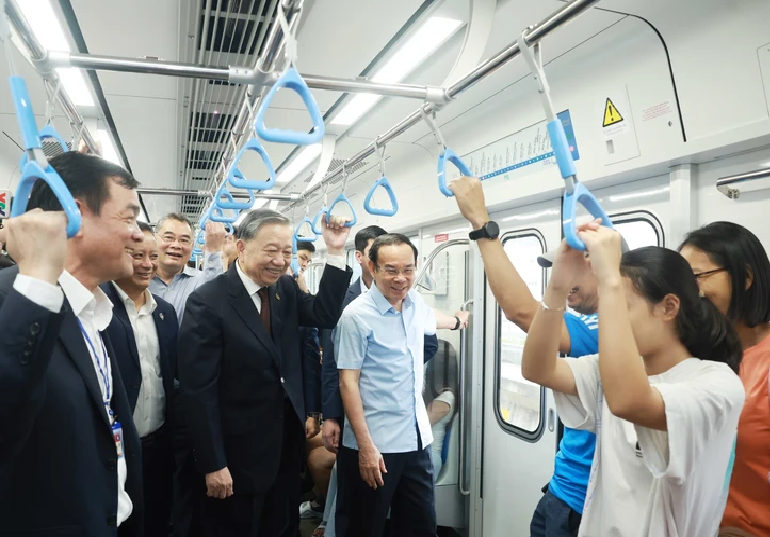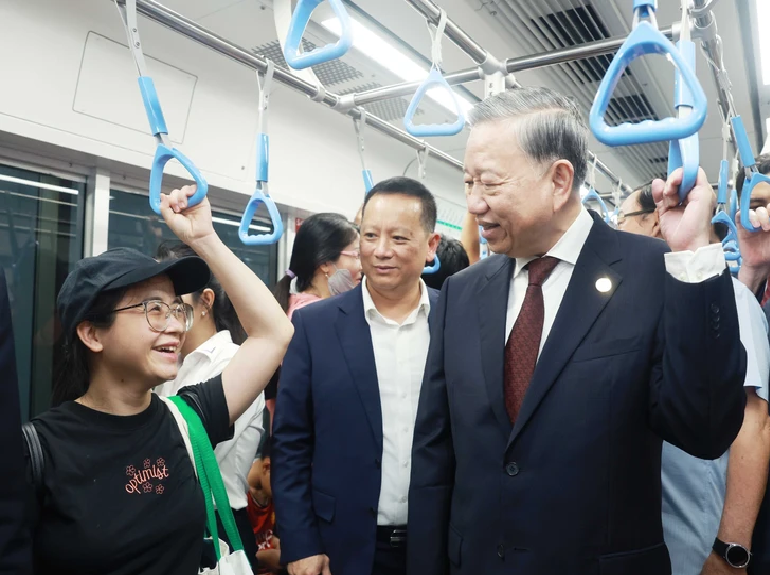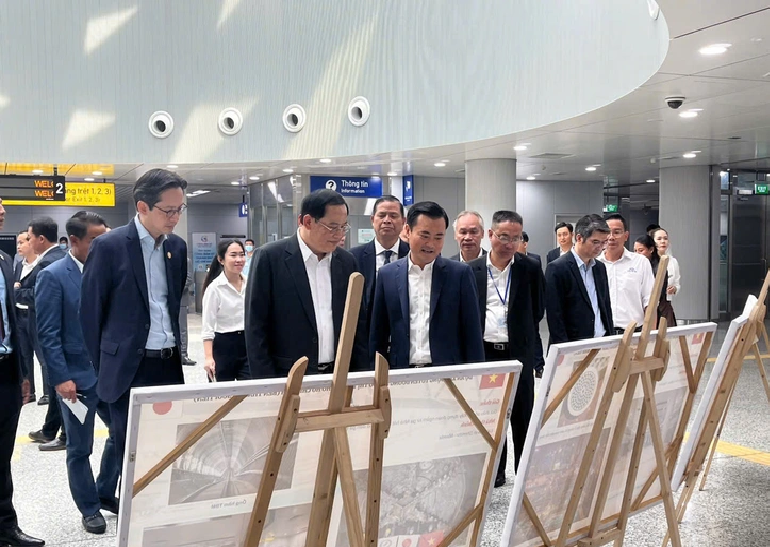Vietnam’s Party General Secretary To Lam rode the Ben Thanh-Suoi Tien metro line No. 1 in Ho Chi Minh City as part of his trip to the southern metropolis on Saturday.
Accompanying the Party leader were secretary of the Ho Chi Minh City Party Committee Nguyen Van Nen, chief of the Party Central Committee's Office Le Hoai Trung, and Deputy Prime Minister and Minister of Foreign Affairs Bui Thanh Son.
During his journey from Ben Thanh Station in District 1 to Tan Cang Station in Binh Thanh District, Party General Secretary Lam had the opportunity to meet and chat warmly with passengers on the train.
These people shared their excitement about using the modern public transport system, which significantly shortens travel time in the city, meets the growing daily commuting needs, and contributes to improving the quality of life.
Le Minh Triet, director of the Ho Chi Minh City Urban Railway No. 1 Co. Ltd. (HURC 1), the operator of the metro line, told Tuoi Tre (Youth) newspaper that during the reception of Party General Secretary Lam’s delegation, the metro line continued to serve passengers as usual.
At Ben Thanh Station, the Party chief had warm conversations with many passengers.
His trip reflects the Party leadership’s deep concern for public transport systems, emphasizing the crucial role of metro line No. 1 in enhancing urban infrastructure, reducing traffic congestion, and improving the quality of life for people in Ho Chi Minh City, Triet added.
|
|
| Party General Secretary To Lam (R) talks with a passenger on a train of the first metro line in Ho Chi Minh City. Photo: Vietnam News Agency |
Earlier the same day, a high-level delegation of Lao Prime Minister Sonexay Siphandone also experienced the metro line.
According to Triet, both delegations were 'special guests,' and HURC 1 was both surprised and pleased to host them.
He shared that since officially operating on December 22, 2024, metro line No. 1 has served 73,000 passengers per day on average.
The modern automated ticketing system, multiple payment options, and flexible pricing policies have all contributed to attracting a large number of passengers.
Metro line No. 1 operates from 5:00 am to 10:00 pm, with intervals between trains ranging from eight to 12 minutes, operating up to 200 daily train trips. During its first week of operation, the line recorded impressive passenger numbers.
During the Lunar New Year (Tet) holiday, the number of passengers was still high, reaching 120,000 on January 30, or the second day of the new lunar year.
As a result, HURC 1 proposed an adjustment to the operation of the metro line, increasing the number of trips and reducing the intervals between them to better serve passengers using the metro line during Tet.
The metro line is integrated with a modern automated ticketing system that offers various payment methods, such as QR codes, the HCMC Metro app, local and international bank cards and MOMO e-wallet, and even with the chip-based citizen ID card.
The ticket pricing is flexible, with one-way tickets ranging from VND7,000 (US$0.3) to VND20,000 ($0.8). Those making cashless payments are entitled to a VND1,000 ($0.04) discount.
A one-day ticket costs VND40,000 ($1.6) per person, with unlimited rides for the day, while a three-day ticket is priced at VND90,000 ($3.5) per person. Monthly passes cost VND300,000 ($11.8) for general passengers and VND150,000 ($5.9) for students.
Individuals recognized for meritorious service, people with disabilities, senior citizens, and children under six are entitled to free metro services.
|
|
| Lao Prime Minister Sonexay Siphandone (first row, L, 2nd) visits a station of the first metro line in Ho Chi Minh City. Photo: HURC 1 |
The inaugural metro line in Ho Chi Minh City is 19.7 kilometers long, including 2.6 kilometers of underground urban rail link and 17.1 kilometers of elevated track, carrying a price tag of VND43.7 trillion ($1.7 billion).
The first metro line project was launched in 2006, and its construction began in 2012.
The line has a total of 17 trains, each capable of accommodating 930 passengers, including 147 sitting and 783 standing.
It is expected to help reduce traffic congestion, providing a fast and convenient mode of transport for people in Ho Chi Minh City.
Like us on Facebook or follow us on Twitter to get the latest news about Vietnam!






















































